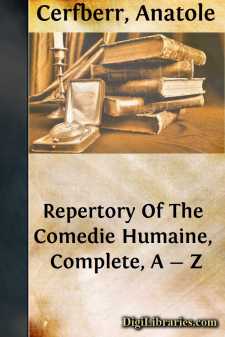Categories
- Antiques & Collectibles 13
- Architecture 36
- Art 48
- Bibles 22
- Biography & Autobiography 813
- Body, Mind & Spirit 142
- Business & Economics 28
- Children's Books 15
- Children's Fiction 12
- Computers 4
- Cooking 94
- Crafts & Hobbies 4
- Drama 346
- Education 46
- Family & Relationships 57
- Fiction 11828
- Games 19
- Gardening 17
- Health & Fitness 34
- History 1377
- House & Home 1
- Humor 147
- Juvenile Fiction 1873
- Juvenile Nonfiction 202
- Language Arts & Disciplines 88
- Law 16
- Literary Collections 686
- Literary Criticism 179
- Mathematics 13
- Medical 41
- Music 40
- Nature 179
- Non-Classifiable 1768
- Performing Arts 7
- Periodicals 1453
- Philosophy 64
- Photography 2
- Poetry 896
- Political Science 203
- Psychology 42
- Reference 154
- Religion 513
- Science 126
- Self-Help 84
- Social Science 81
- Sports & Recreation 34
- Study Aids 3
- Technology & Engineering 59
- Transportation 23
- Travel 463
- True Crime 29
Repertory of the Comedie Humaine Part 1
by: Anatole Cerfberr
Categories:
Description:
Excerpt
TRANSLATOR'S PREFACE
"Work crowned by the French Academy" is a significant line borne by the title-page of the original edition of Messieurs Cerfberr and Christophe's monumental work. The motto indicates the high esteem in which the French authorities hold this very necessary adjunct to the great Balzacian structure. And even without this word of approval, the intelligent reader needs but a glance within the pages of the Repertory of the Comedie Humaine to convince him at once of its utility.
In brief, the purpose of the Repertory is to give in alphabetical sequence the names of all the characters forming this Balzacian society, together with the salient points in their lives. It is, of course, well known that Balzac made his characters appear again and again, thus creating out of his distinct novels a miniature world. To cite a case in point, Rastignac, who comes as near being the hero of the Comedie as any other single character, makes his first appearance in Father Goriot, as a student of law; then appearing and disappearing fitfully in a score of principal novels, he is finally made a minister and peer of France. Without the aid of the Repertory it would be difficult for any save a reader of the entire Comedie to trace out his career. But here it is arranged in temporal sequence, thus giving us a concrete view of the man and his relation to this society.
In reading any separate story, when reference is made in passing to a character, the reader will find it helpful and interesting to turn to the Repertory and find what manner of man it is that is under advisement. A little systematic reading of this nature will speedily render the reader a "confirmed Balzacian."
A slight confusion may arise in the use of the Repertory on account of the subdivision of titles. This is the fault neither of Messieurs Cerfberr and Christophe nor of the translator, but of Balzac himself, who was continually changing titles, dividing and subdividing stories, and revamping and working other changes in his books. Cousin Betty and Cousin Pons were placed together by him under the general title of Poor Relations. Being separate stories, we have retained the separate titles. Similarly, the three divisions of Lost Illusions were never published together until 1843—in the first complete edition of the Comedie; before assuming final shape its parts had received several different titles. In the present text the editor has deemed it best to retain two of the parts under Lost Illusions, while the third, which presents a separate Rubempre episode, is given as A Distinguished Provincial at Paris. The three parts of The Thirteen—Ferragus, The Duchess of Langeais, and The Girl with the Golden Eyes—are given under the general title. The fourth part of Scenes from a Courtesan's Life, Vautrin's Last Avatar, which until the Edition Definitive had been published separately, is here merged into its final place. But the three parts of The Celibates —Pierrette, The Vicar of Tours and A Bachelor's Establishment, being detached, are given separately....




